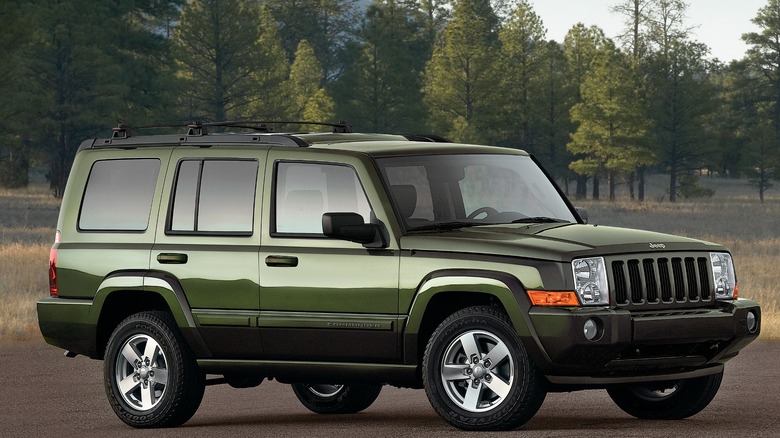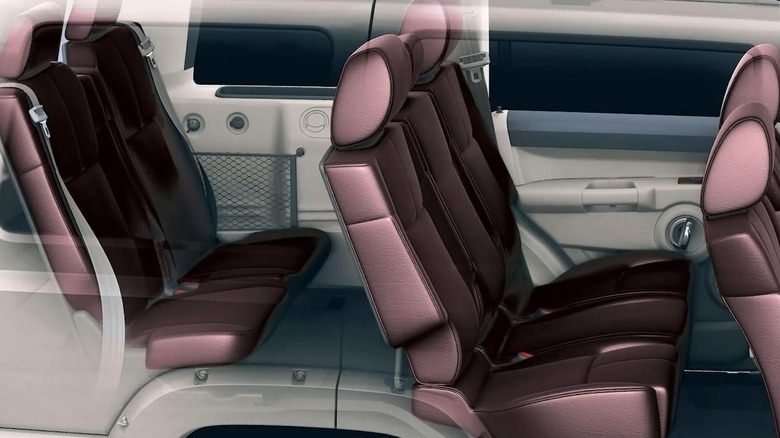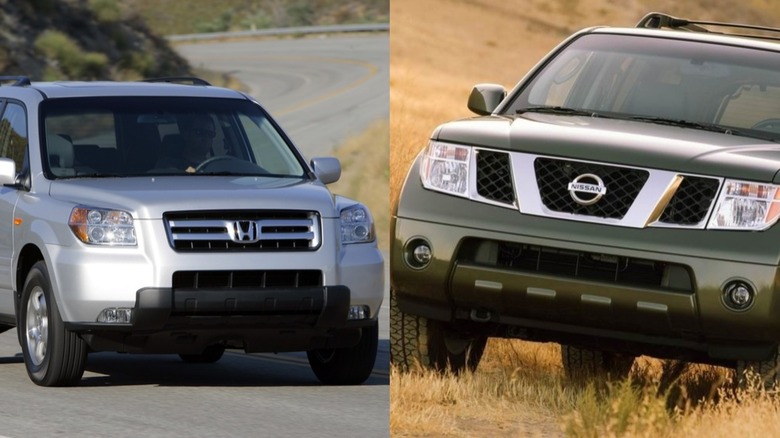Here's Why Jeep Discontinued The Commander After Just 5 Years
The mid-2000s saw the launch of new SUV that offered three-rows of seating, off-road capability, and V8 engine options. The Jeep Commander was the automakers answer to popular competitors like the Honda Pilot, Ford Explorer, and Toyota Highlander. One version of Commander even featured a 5.7L Hemi V8, making it one of the most powerful Jeep models ever built. This SUV was built using the Grand Cherokee as a foundation, which was a strong starting point. However, this seven-seat SUV struggled to attract buyers, and its strongest sales year of 2006 only saw 88,497 units sold in the U.S., per GoodCarBadCar.com. The Jeep Commander, which seemed like a slam dunk on paper, was only produced from 2005 until being discontinued in 2010.
There were a few glaring reasons this SUV didn't achieve success and ultimately, had to be shelved. First, the Commander offered three-rows of seating, but Jeep failed to make the extra space comfortable. There were also some great alternatives from competing automakers. But the Commander still has its fans who, despite a short production run, insist it belongs alongside the best Jeeps of all time.
A cramped interior and unappealing design
The automaker was wise to use the Grand Cherokee as a basis for its new larger SUV, but the company made a critical mistake. Instead of extending the wheelbase beyond the Grand Cherokee's dimensions and adapting the chassis to accommodate a spacious three-row configuration, designers ultimately left it virtually unchanged, and ultimately both the Jeep Commander and Grand Cherokee shared the same 109.5-inch wheelbase. This created a problem with the third-row which sat higher inside the vehicle, above the rear wheels. That configuration left passengers with unreasonably little head room at 35.7 inches and confined leg room at 28.9 inches. Even though the Grand Cherokee didn't offer the extra passenger capacity, its back seat was much more roomy, with 39.3 inches of headroom, and 35.5 inches of legroom.
The boxy body shape of the Jeep Commander also didn't win over many drivers, especially when compared to the more aerodynamic and sleeker Grand Cherokee. The more upright windshield, sharply squared corners and raised roof above the third-row made this SUV look dated. One reviewer, whose headline called the car "ugly," recounted that in the week they had the vehicle, no one around them had nice things to say. "Comments were more of the 'dang' variety."
Readers might argue the Commander was more boring than ugly. It was certainly more visually appealing than the Jeep Treo, which was one of the weirdest SUVs ever made.
Better alternatives
The Commander, while very capable off-road in the tradition of Jeep products, didn't seem to do anything else better than the competition. The 2006 Honda Pilot for example, can seat up to eight people, and features a cargo capacity of 15.9 cubic feet when all seats are upright. The 2006 Jeep Commander on the other hand, offered less than half that at 7.5 cubic feet.
In terms of performance, other than the more robust 5.7L Hemi option, the Commander was a bit underpowered. For example, the 2006 base level, 4WD model comes equipped with a 3.7L V6 that generates less horsepower and torque than a similarly equipped Honda Pilot or Nissan Pathfinder.
With the Jeep Commander outputting less power than similar alternatives, you might expect it would at least offer greater efficiency. However, when compared to either the Pathfinder or the Pilot, Jeep's SUV fared worse in terms of EPA estimated fuel economy too. With a combined city/highway rating of 16 miles, the Commander was largely the same as the similarly-equipped Nissan's estimate even though the Pathfinder produced substantially higher performance figures. The Honda managed a slightly better combined estimate, while also producing more potent output.


